#INterior exploration using Seismic Investigations Geodesy and Heat Transport (InSight)
Explore tagged Tumblr posts
Text
Scientists torturing backronyms/acronyms happens a lot, actually (see my tags for examples)
Backronyms
Physicists suck at naming things (I can say this because I'm a MechE and I have had to deal with so many physicists), but occasionally they have a stroke of brilliance. Like, a friend of mine worked on a dark matter detector called DarkSide. That's so goofy that it wraps back around to good.
Anyway, there's this superconducting fusion reactor in france called WEST. It's notable for having first-wall shielding tiles (the innermost surface of the vacuum chamber, directly facing the fusion plasma) entirely made of tungsten.
There are a lot of materials used for plasma-facing components – tungsten, molybdenum, graphite, beryllium, various composites and combinations of the above – but it's pretty rare for a reactor to go full tungsten. It can take extremely high temperatures, but it's brittle and expensive, and "high-Z" (high molecular weight) impurities in the plasma cause their own issues. So, the main purpose of WEST is to investigate the viability of an all-tungsten first wall and divertor.
To that end, they tortured an acronym until they got it to work:
Tungsten Environment in Steady-state Tokamak
Or "WEST"

Get it?
GEW IW??
#let me name a few from mars-related things in order of least to most ridiculous:#one of the least bad ones: Mars Atmosphere and Volatile EvolutioN (MAVEN)#INterior exploration using Seismic Investigations Geodesy and Heat Transport (InSight)#ESCApe and Plasma Acceleration and Dynamics Explorer (ESCAPADE) (they really used 67% of the whole word there huh)#MArs RadIation environment Experiment (MARIE) (radiation detector on Mars Odyssey)#TElescopic Nadir imager for GeOmOrphology (TENGOO) (a camera on MMX)#Mars-moon Exploration with GAmma rays and NEutrons (MEGANE) (spectrometer on MMX) (MMX team sure loves destroying backronyms)#Optical RadiOmeter composed of CHromatic Imagers (OROCHI) (could you guess it's MMX again?)#that's all I can find off the top of my head but here please be as tortured as I am about this#EDIT: I FORGOT TO MENTION SCHIAPARELLI LANDER'S OFFICIAL NAME#ExoMars EDM#EDM standing for EDL Demonstrator Module#EDL standing for Entry Descent and Landing#they shoved a whole-ass acronym in their acronym
978 notes
·
View notes
Text
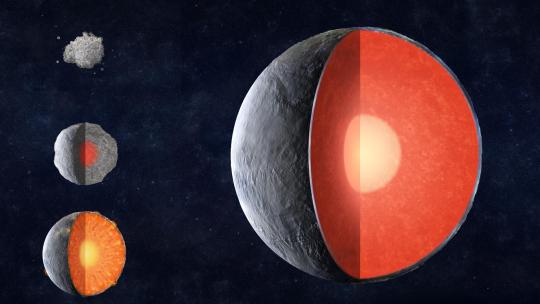
"A Rocky Planet Forms
An artist's rendition of how a rocky planet forms.
As a rocky planet forms, the planet-forming material gathers in a process known as 'accretion.' It grows larger in size, and increases in temperature, along with the pressure at its core. The energy from this initial planet forming process causes the planet's elements to heat up and melt. Upon melting, layers form and separate. The heavier elements sink to the bottom, the lighter ones float to the top. This material then separates into layers as it cools, which is known as 'differentiation.' A fully formed planet slowly emerges, with an upper layer known as the crust, the mantle in the middle, and a solid iron core.
InSight is short for Interior Exploration using Seismic Investigations, Geodesy and Heat Transport. The InSight mission will help answer key questions about how the rocky planets of the solar system, as well as how rocky exoplanets, formed. So while InSight is a Mars mission, it's also more than a Mars mission.
The lander seeks the fingerprints of the processes that formed the rocky planets of the solar system, more than 4 billion years ago. It measures the planet's 'vital signs:' its 'pulse' (seismology), 'temperature' (heat flow) and 'reflexes' (precision tracking)."
Date: January 25, 2018
NASA ID: PIA22233
#Planet#Planetary Formation#Rocky Planet#InSight#NASA#Concept Art#cross section#January#2018#my post
10 notes
·
View notes
Text

Weighing in on a Mars water debate
More than 3 billion years ago, Mars intermittently had liquid water on its surface. After the planet lost much of its atmosphere, however, surface water could no longer persist. The fate of Mars’ water—whether it was buried as ice, confined in deep aquifers, incorporated into minerals or dissipated into space—remains an area of ongoing research, one of particular interest to LASP Senior Research Scientist Bruce Jakosky, former principal investigator of the Mars Atmosphere and Volatile EvolutioN (MAVEN) mission.
Last week, in a letter to the editor of the Proceedings of the National Academy of Sciences (PNAS), Jakosky challenged the conclusion of a 2024 PNAS study that suggested Mars retains a significant amount of liquid water in its mid-crust. Jakosky notes that while that is one possible conclusion, it is not the only one, as the data on which the study is based do not require a water-saturated crust.
“While the approach and analysis are reasonable and appropriate, the results of their modeling suggest an alternative conclusion,” Jakosky says.
The data used in the analyses came from NASA’s Interior Exploration using Seismic Investigations, Geodesy and Heat Transport (InSight) mission, which launched in 2018 and placed a single lander on Mars to collect geophysical data to study the planet’s interior. Although the mission ended in 2022, when a Martian dust storm obscured the lander’s solar panels preventing them from generating power, scientists are still analyzing data from InSight—and debating what it means.
In an August 2024 PNAS study, geophysicist Vashan Wright, of the Scripps Institution of Oceanography at the University of California, San Diego, and colleagues used rock physics models to determine what types of rocks, levels of water saturation, and pore space characteristics could account for the seismic and gravity data InSight had collected from the mid-crust, a region ranging from 11.5 to 20 kilometers below the surface.
The team concluded that a mid-crust made up of fractured igneous rocks saturated with liquid water “best explains the existing data.” They estimated the volume of trapped water would reach a depth of between one and two kilometers—if it were spread evenly across the planet’s surface, a measure called the global equivalent layer. For comparison, Earth’s global equivalent layer is 3.6 kilometers, which is due almost entirely to the oceans, with very little water in the crust.
“We expect there to be water or ice in the crust,” Jakosky says. “Actually detecting it and possibly determining its abundance is challenging, but extremely important for understanding how much water there is on Mars and what its history has been.”
Jakosky’s reexamination of the model results considered how the pore space is distributed and other conditions, like the presence of solid ice or empty pore spaces, which could also explain the seismic and gravity data InSight collected. While the InSight data do not require the presence of water in the mid-crust, Jakosky says, they also do not rule it out. After factoring in the distribution of pore space, he concluded the global equivalent layer could range from zero to two kilometers, expanding the lower limit found by the previous study.
The amount of water present in Mars’ crust is a question that further missions—to conduct more detailed geological analysis and observations, including more advanced seismic profiling—could one day help answer. Additional implications of the findings include a better understanding of the Red Planet’s water cycle, its potential conditions for life, and the availability of resources for future missions.
8 notes
·
View notes
Text
Current Mars Missions
Mars Science Laboratory - Curiosity Rover
Launch Date: November 26, 2011
Landing Date: August 6, 2012
Mission Overview: The Curiosity Rover was designed to explore Gale Crater on Mars as part of NASA's Mars Science Laboratory mission. It aims to investigate Mars' climate and geology and assess whether Gale Crater ever offered environmental conditions favorable for microbial life.
Key Findings: Curiosity has discovered evidence of ancient water flows, complex organic molecules, and a methane cycle, which may indicate past habitability.
InSight Lander
Launch Date: May 5, 2018
Landing Date: November 26, 2018
Mission Overview: InSight (Interior Exploration using Seismic Investigations, Geodesy, and Heat Transport) is a NASA mission designed to study the deep interior of Mars. Its primary goal is to understand the formation and evolution of terrestrial planets by measuring the planet's seismic activity and heat flow.
Key Findings: InSight has detected marsquakes, which provide insights into Mars' interior structure. It has also measured the heat flow from the planet’s interior and collected data on its weather.
Mars 2020 - Perseverance Rover
Launch Date: July 30, 2020
Landing Date: February 18, 2021
Mission Overview: The Perseverance Rover aims to search for signs of ancient life and collect rock and soil samples for potential return to Earth. It carries advanced scientific instruments and the Ingenuity helicopter, which has performed the first powered flight on another planet.
Key Findings: Perseverance has collected samples that will be stored for future missions to return to Earth. It has also demonstrated the first oxygen production from the Martian atmosphere.
Future Mars MissionsExoMars 2022 (Rosalind Franklin Rover)
Launch Date: Currently planned for 2028 (delayed from 2022)
Mission Overview: ExoMars is a joint mission by the European Space Agency (ESA) and Roscosmos. The Rosalind Franklin Rover will search for signs of past life beneath the Martian surface and drill up to two meters to collect samples.
Key Objectives: The rover will analyze the subsurface environment, focusing on the chemical, physical, and biological properties of Martian soil and rock.Mars Sample Return
Mission Launch Date: Targeted for the late 2020s to early 2030s
Mission Overview: This mission is a collaborative effort between NASA and ESA to bring back samples collected by the Perseverance Rover. The mission involves a series of steps, including launching a fetch rover to collect the samples, launching a Mars Ascent Vehicle (MAV) to send them into Mars orbit, and capturing them with an Earth Return Orbiter.
Key Objectives: The goal is to bring back Martian samples to Earth for detailed analysis in laboratories, which will provide unprecedented insights into the planet's geology and potential biosignatures.China's Tianwen-3 Mission
Launch Date: Planned for the 2030s
Mission Overview: Building on the success of the Tianwen-1 mission, Tianwen-3 aims to conduct a sample return mission from Mars. It will involve a lander, rover, and ascent vehicle to collect and return samples.
Key Objectives: Similar to the NASA/ESA Mars Sample Return, Tianwen-3 seeks to bring back Martian soil and rock samples to Earth for extensive scientific study.
Significance of Mars Missions
The exploration of Mars is crucial for several reasons:Scientific Understanding: By studying Mars' geology, climate, and potential biosignatures, we gain insights into the planet's history and the possibility of life beyond Earth.
Future Human Exploration: These missions lay the groundwork for future human missions to Mars by testing new technologies, understanding the Martian environment, and identifying potential resources.International Collaboration: Mars missions often involve international partnerships, advancing global scientific cooperation and pooling resources for more ambitious endeavors.
Mars missions are a testament to human ingenuity and curiosity, pushing the boundaries of what we can achieve in space exploration. Each mission builds on the knowledge gained from previous ones, bringing us closer to understanding the Red Planet and our place in the universe.
0 notes
Link
Radioisotope Thermoelectric Generators (RTGs) have a long history of service in space exploration. Since the first was tested in space in 1961, RTGs have gone on to be used by 31 NASA missions, including the Apollo Lunar Surface Experiments Packages (ALSEPs) delivered by the Apollo astronauts to the lunar surface. RTGs have also powered the Viking 1 and 2 missions to Mars, the Ulysses mission to the Sun, Galileo mission to Jupiter, and the Pioneer, Voyager, and New Horizons missions to the outer Solar System – which are currently in (or well on their way to) interstellar space. In recent years, RTGs have allowed the Curiosity and Perseverance rovers to continue the search for evidence of past (and maybe present) life on Mars. In the coming years, these nuclear batteries will power more astrobiology missions, like the Dragonfly mission that will explore Saturn’s largest moon, Titan. In recent years, there has been concern that NASA was running low on Plutonium-238, the key component for RTGs. Luckily, the U.S. Department of Energy (DOE) recently delivered a large shipment of plutonium oxide, putting it on track to realize its goal of regular production of the radioisotopic material. The recent shipment of 0.5 kg (over 1 lb) of plutonium oxide from the U.S. Department of Energy’s (DOE’s) Oak Ridge National Laboratory to its Los Alamos National Laboratory is critical to realize NASA’s planned future missions. It is also the largest shipment since the DOE issued its report to Congress in 2010 – “Startup Plan for Plutonium-238 Production for Radioisotope Power Systems.” As per this plan, this delivery is a significant step toward achieving the goal of a sustained annual production rate of 1.5 kg (3.3 lbs) by 2026. Like all radioisotope power systems (RPS), RTGs rely on the natural decay of the radioisotope plutonium-238 to provide heat for a Light Weight Radioisotope Heater Unit (LWRHU) or heat and electricity for a Multi-Mission Radioisotope Thermoelectric Generator (MMRTG). These systems are vital to space exploration since they enable exploration to some of the deepest, darkest, and most distant destinations in the Solar System (and beyond). In short, they enable missions to locations where solar power is limited, intermittent, or unavailable. Consider NASA’s Opportunity rover, which explored the surface of Mars for almost 15 years, establishing multiple records in the process, but was lost in 2018 when a planet-wide storm caused a huge dust buildup on its solar panels. A similar fate claimed NASA’s Interior Exploration using Seismic Investigations, Geodesy, and Heat Transport (InSight) lander, which recently concluded its mission to explore Mars’ interior structure and seismic environment after four years. Once again, the culprit was dust buildup on the mission’s solar panels, which caused its battery to die. The first spacecraft to benefit from this restart was the Perseverance rover, which carries some of the new plutonium produced by DOE. An MMRTG continuously provides the rover with heat and about 110 watts of electricity, keeping its instruments powered during the day and its batteries warm at night. As Carl Sandifer, the RPS program manager at NASA’s Glenn Research Center, said in a recent NASA press statement, “NASA’s Radioisotope Power Systems Program works in partnership with the Department of Energy to enable missions to operate in some of the most extreme environments in our solar system and interstellar space.” NASA and other space agencies are also investigating nuclear systems to provide power for future exploration missions. This includes compact nuclear generators for powering habitats on the Moon and Mars, known as Kilopower Reactor Using Sterling TechnologY (KRUSTY) reactors. There are also plans to resurrect the Space Race-era Nuclear Engine for Rocket Vehicle Applications (NERVA) technology to create spacecraft equipped with nuclear-thermal and nuclear-electric propulsion, which could enable missions to Mars in less than 100 days. For over sixty years, NASA has relied on radioisotope-based electrical power systems and heater units to advance space exploration and the frontiers of science. With the restart of this program, NASA and DOE have signaled their intent to maintain their long-standing partnership to ensure that the U.S. space program can enable missions requiring radioisotopes for decades to come. As we explore farther from Earth, establish outposts beyond Low Earth Orbit (LEO), and contemplate missions to nearby stars, nuclear power will play a vital role. Further Reading: NASA The post NASA is Getting the Plutonium it Needs for Future Missions appeared first on Universe Today.
0 notes
Text
Il più grande terremoto marziano di InSight è stato probabilmente causato da processi geologici
Una illustrazione del lander InSight su Marte. Durante la sua permanenza su Marte, il lander InSight (Interior Exploration using Seismic Investigations, Geodesy and Heat Transport) della NASA ha registrato oltre 1.300 eventi sismici, noti come marsquakes. Di questi, alcuni sono stati identificati come provenienti da eventi di craterizzazione da impatto di meteoriti sulla superficie del pianeta.…
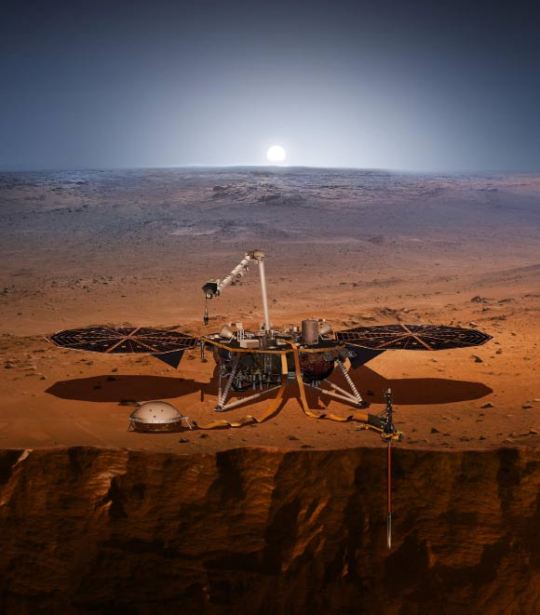
View On WordPress
0 notes
Video
instagram
nasa Spread your solar wings! Our next mission to Mars – the InSight lander – extended the solar arrays that will power the spacecraft once it lands on the Red Planet this November during a test to confirm the solar cells were collecting power. The fan-like solar panels are specially designed for Mars' weak sunlight, caused by the planet's distance from the Sun and its dusty, thin atmosphere. InSight (Interior Exploration using Seismic Investigations, Geodesy and Heat Transport) is a terrestrial planet explorer that will study the Red Planet’s deep interior. This mission will also address one of the most fundamental issues of planetary and solar system science: understanding the processes that shaped the rocky planets of the inner solar system – including Earth – more than four billion years ago. Credit: @lockheedmartin
#Geophysics#insight#nasa#nature#space#spacecraft#mission#the earth story#Interior Exploration using Seismic Investigations Geodesy and Heat Transport#heat flow
154 notes
·
View notes
Photo

From NASA Image of the Day; May 4, 2018:
Voyage to the Red Planet
All systems are go for NASA’s next launch to the Red Planet.
Saturday's early-morning liftoff of the InSight Mars lander will mark the first time an interplanetary launch has originated from the West Coast. InSight is scheduled to launch from Vandenberg Air Force Base Space Launch Complex 3E on May 5, during a two-hour launch window opening at 4:05 a.m. PDT (7:05 a.m. EDT).
InSight, for Interior Exploration using Seismic Investigations, Geodesy and Heat Transport, will launch aboard a United Launch Alliance Atlas V rocket on a journey to study the deep interior of Mars to learn how all rocky planets formed, including Earth and its Moon. The lander's instruments include a seismometer to detect marsquakes, and a probe that will monitor the flow of heat from the planet's interior.
In this image from May 3, 2018, ULA's Atlas V rocket is seen with NASA's InSight spacecraft onboard.
Image Credit: NASA/Bill Ingalls
#nasa image of the day#Mars#mars lander#InSight#Interior Exploration using Seismic Investigations Geodesy and Heat Transport#rocket#Atlas V#Vandenberg Air Force Base#Vandenberg Air Force Base Space Launch Complex#California
1 note
·
View note
Photo
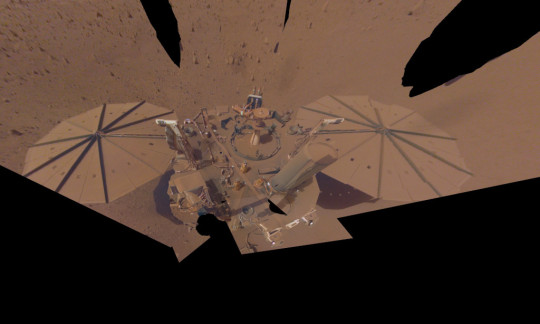
2022 November 4
InSight's Final Selfie Image Credit: NASA, JPL-Caltech, Mars InSight
Explanation: The Mars InSight lander returned its first image from the Red Planet's flat, equatorial Elysium Planitia after a successful touchdown on November 26, 2018. The history making mission to explore the martian Interior using Seismic investigations, geodesy, and heat transport has been operating for over 1,400 martian days or sols. In that time the InSight mission has detected more than 1,300 marsquakes and recorded data from Mars-shaking meteoroid impacts, observing how the seismic waves travel to provide a glimpse inside Mars. Analyzing the archive of data collected is expected to yield discoveries for decades. But InSight's final operational sol is likely not far off. The reason is evident in this selfie recorded earlier this year showing its deck and large, 2-meter-wide solar panels covered with dust. Kicked up by martian winds the dust continues to accumulate and drastically reduce the power that can be generated by InSight's solar panels.
∞ Source: apod.nasa.gov/apod/ap221104.html
74 notes
·
View notes
Photo

InSight's Final Selfie The Mars InSight lander returned its first image from the Red Planet's flat, equatorial Elysium Planitia after a successful touchdown on November 26, 2018. The history making mission to explore the martian Interior using Seismic investigations, geodesy, and heat transport has been operating for over 1,400 martian days or sols. In that time the InSight mission has detected more than 1,300 marsquakes and recorded data from Mars-shaking meteoroid impacts, observing how the seismic waves travel to provide a glimpse inside Mars. Analyzing the archive of data collected is expected to yield discoveries for decades. But InSight's final operational sol is likely not far off. The reason is evident in this selfie recorded earlier this year showing its deck and large, 2-meter-wide solar panels covered with dust. Kicked up by martian winds the dust continues to accumulate and drastically reduce the power that can be generated by InSight's solar panels.
2 notes
·
View notes
Photo
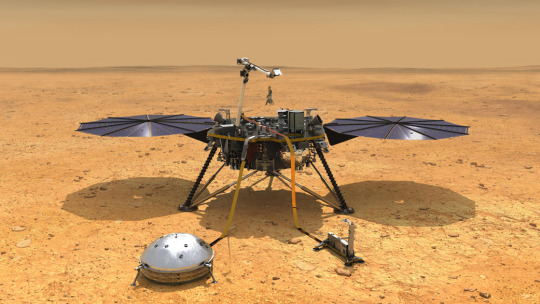
3 Things We've Learned From NASA's Mars InSight
Scientists are finding new mysteries since the geophysics mission landed two years ago.
NASA's InSight spacecraft touched down Nov. 26, 2018, on Mars to study the planet's deep interior. A little more than one Martian year later, the stationary lander has detected more than 480 quakes and collected the most comprehensive weather data of any surface mission sent to Mars. InSight's probe, which has struggled to dig underground to take the planet's temperature, has made progress, too.
There was a time when the surfaces of Mars and Earth were very similar. Both were warm, wet, and shrouded in thick atmospheres. But 3 or 4 billion years ago, these two worlds took different paths. The mission of InSight (short for Interior Exploration using Seismic Investigations, Geodesy and Heat Transport) has been to help scientists to compare Earth to its rusty sibling. Studying what the depths of Mars is made of, how that material is layered, and how quickly heat seeps out of it could help scientists better understand how a planet's starting materials make it more or less likely to support life.
While there's more science to come from InSight, here are three findings about our red neighbor in the sky.
Read more ~ nasa.gov/feature/jpl/3-things
8 notes
·
View notes
Photo

InSight Mars Mission Lifts Off From Vandenberg Air Force Base : The NASA InSight spacecraft launches onboard a United Launch Alliance Atlas-V rocket, Saturday, May 5, 2018, from Vandenberg Air Force Base in California. InSight, short for Interior Exploration using Seismic Investigations, Geodesy and Heat Transport, is a Mars lander designed to study the "inner space" of Mars: its crust, mantle, and core. (via NASA)
563 notes
·
View notes
Text
Two Steps Forward in the Search for Life on Mars
We haven’t found aliens but we are a little further along in our search for life on Mars thanks to two recent discoveries from our Curiosity Rover.

We detected organic molecules at the harsh surface of Mars! And what’s important about this is we now have a lot more certainty that there’s organic molecules preserved at the surface of Mars. We didn’t know that before.
One of the discoveries is we found organic molecules just beneath the surface of Mars in 3 billion-year-old sedimentary rocks.

Second, we’ve found seasonal variations in methane levels in the atmosphere over 3 Mars years (nearly 6 Earth years). These two discoveries increase the chances that the record of habitability and potential life has been preserved on the Red Planet despite extremely harsh conditions on the surface.

Both discoveries were made by our chem lab that rides aboard the Curiosity rover on Mars.

Here’s an image from when we installed the SAM lab on the rover. SAM stands for “Sample Analysis at Mars” and SAM did two things on Mars for this discovery.
One - it tested Martian rocks. After the arm selects a sample of pulverized rock, it heats up that sample and sends that gas into the chamber, where the electron stream breaks up the chemicals so they can be analyzed.
youtube
What SAM found are fragments of large organic molecules preserved in ancient rocks which we think come from the bottom of an ancient Martian lake. These organic molecules are made up of carbon and hydrogen, and can include other elements like nitrogen and oxygen. That’s a possible indicator of ancient life…although non-biological processes can make organic molecules, too.
The other action SAM did was ‘sniff’ the air.
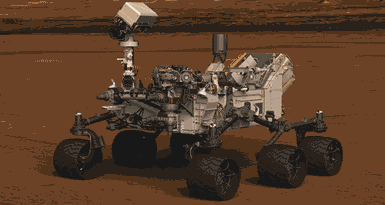
When it did that, it detected methane in the air. And for the first time, we saw a repeatable pattern of methane in the Martian atmosphere. The methane peaked in the warm, summer months, and then dropped in the cooler, winter months.

On Earth, 90 percent of methane is produced by biology, so we have to consider the possibility that Martian methane could be produced by life under the surface. But it also could be produced by non-biological sources. Right now, we don’t know, so we need to keep studying the Mars!

One of our upcoming Martian missions is the InSight lander. InSight, short for Interior Exploration using Seismic Investigations, Geodesy and Heat Transport, is a Mars lander designed to give the Red Planet its first thorough checkup since it formed 4.5 billion years ago. It is the first outer space robotic explorer to study in-depth the "inner space" of Mars: its crust, mantle, and core.
Finding methane in the atmosphere and ancient carbon preserved on the surface gives scientists confidence that our Mars 2020 rover and ESA’s (European Space Agency's) ExoMars rover will find even more organics, both on the surface and in the shallow subsurface.
Read the full release on today’s announcement HERE.
Make sure to follow us on Tumblr for your regular dose of space: http://nasa.tumblr.com.
#nasa#space#science#mars#curiosity#methane#carbon#life#searchforlife#redplanet#planet#solarsystem#exploration
4K notes
·
View notes
Text
NASA’s InSight Spacecraft Has Touched Down on Mars
NASA - InSight Mission logo. Nov. 26, 2018 NASA’s InSight lander will complete its seven-month journey to the Red Planet.
InSight EDL, final approach of Mars. Image Credit: NASA
Image above: NASA's twin MarCO spacecraft are scheduled to make a flyby of Mars on Nov. 26. On Nov. 24, a wide-angle camera on MarCO-B took this picture of the Red Planet, which appears as small, grey dot in the lower left quadrant of the image. Image Credits: NASA/JPL-Caltech.
InSight Prepares to Enter Martian Atmosphere. Animation Credit: CNES
Mission controllers at NASA’s Jet Propulsion Laboratory in Pasadena, California, have completed the final adjustments for landing NASA’s InSight spacecraft on Mars.
InSight atmospheric entry. Animation Credits: NASA/JPL-Caltech
Atmospheric entry is expected around 11:47 p.m. PST (2:47 p.m. EST) and touchdown, about seven minutes later. NASA’s InSight lander has separated from the cruise stage. It is turning to orient its heat shield in preparation for the entry, descent and landing process at Mars.
MarCO CubeSats Relaying InSight Data: Image Credit: NASA
First CubeSats to deep space — Mars Cube One A and B — have begun to relay communications from the InSight spacecraft as it lands on Mars. MarCOs’ transmissions may be interrupted during the landing process, but their signals do not affect whether InSight completes its activities.
Heat shield separation. Animation Credits: NASA/JPL-Caltech
InSight descent on Mars. Image Credits: NASA/JPL-Caltech
NASA’s InSight has begun its entry, descent and landing phase at Mars. Within seven minutes of entering the atmosphere, the spacecraft is expected to deploy its parachute, separate from its heat shield, pop out its landing legs, turn on its landing radar and start firing its retrorockets as it separates from its back shell. Touchdown is expected around 11:54 a.m. PST (2:54 p.m. EST).
InSight Mars landing. Image Credits: NASA/JPL-Caltech
Engineers be huddled with scientists at JPL on Nov. 26, watching with nervous anticipation for signals that InSight successfully touched down, and a few seconds after... Touchdown!
Solar panels opening. Animation Credits: NASA/JPL-Caltech
NASA's Interior Exploration using Seismic Investigations, Geodesy and Heat Transport (InSight) lander firing retrorockets to slow down as it descends toward the surface of Mars. Credits: NASA/JPL-Caltech.
Image above: Mission controllers at NASA’s Jet Propulsion Laboratory in Pasadena, California, celebrate InSight landing mission success. Image Credit: NASA. Mission controllers at NASA-JPL have received a signal from NASA’s InSight lander on the Mars surface via MarCO OR a beep from InSight’s X-band radio. In the coming hours, engineers will be checking on the spacecraft’s health. A post-landing news briefing expected at 2 p.m. PST (5 p.m. EST).
InSight instruments deployment. Animation Credits: NASA/JPL-Caltech
"It's taken more than a decade to bring InSight from a concept to a spacecraft approaching Mars — and even longer since I was first inspired to try to undertake this kind of mission," said Bruce Banerdt of JPL, InSight's principal investigator. "But even after landing, we'll need to be patient for the science to begin." It will take two to three months for InSight's robotic arm to set the mission's instruments on the surface. During that time, engineers will monitor the environment and photograph the terrain in front of the lander. Back at JPL, the surface operations team will practice setting down the instruments. They'll use a working replica of InSight in an indoor "Mars sandbox," which will be sculpted to match the mission's actual landing site on Mars. The team will check to make sure the instruments can be deployed safely, even if there are rocks nearby or InSight lands at an angle.
NASA’s InSight landed on Mars!
Video above: NASA’s InSight mission successfully landed on Elysium Planitia, Mars, on 26 November 2018, at around 19:54 UTC (12:54 PST, 15:54 EST). The InSight lander, short for Interior Exploration using Seismic Investigations, Geodesy and Heat Transport, is a NASA mission designed to study Mars’ interior structure.
Animation Credits: NASA/JPL-Caltech
Once the final position of each instrument is decided, it will take several weeks to carefully lift each one and calibrate their measurements. Then the science really gets underway. About InSight: JPL manages InSight for NASA's Science Mission Directorate. InSight is part of NASA's Discovery Program, managed by the agency's Marshall Space Flight Center in Huntsville, Alabama. Lockheed Martin Space in Denver built the InSight spacecraft, including its cruise stage and lander, and supports spacecraft operations for the mission. A number of European partners, including France's Centre National d'Études Spatiales (CNES), the Institut de Physique du Globe de Paris (IPGP) and the German Aerospace Center (DLR), are supporting the InSight mission. CNES and IPGP provided the Seismic Experiment for Interior Structure (SEIS) instrument, with significant contributions from the Max Planck Institute for Solar System Research (MPS) in Germany, the Swiss Institute of Technology (ETH) in Switzerland, Imperial College and Oxford University in the United Kingdom, and JPL. DLR provided the Heat Flow and Physical Properties Package (HP3) instrument, with significant contributions from the Space Research Center (CBK) of the Polish Academy of Sciences and Astronika in Poland. Spain’s Centro de Astrobiología (CAB) supplied the wind sensors. For more detailed information on the InSight mission, visit: https://mars.nasa.gov/insight For more information about MarCO, visit: https://www.jpl.nasa.gov/cubesat/missions/marco.php Animations (mentioned), Images (mentioned), Video, Text, Credits: NASA/NASA TV/SciNews. Best regards, Orbiter.ch Full article
137 notes
·
View notes
Text
Postcards from Mars
NASA’s InSight rover has sent back its first images of Mars.
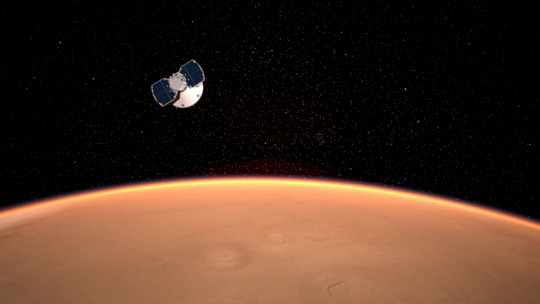
By Ceri Jones
If you missed it, on 26 November, NASA’s InSight lander touched down on Mars, marking the eighth successful landing on the Red Planet.
The robot - full name Interior Exploration using Seismic Investigations, Geodesy and Heat Transport (InSight) - took nearly seven months to make the 458 million kilometre journey from California, USA to an area on the Mars equator, named Elysium Planitia.
NASA Administrator Jim Bridenstine said, ‘InSight will study the interior of Mars and will teach us valuable science as we prepare to send astronauts to the Moon and later to Mars.’
Soon after landing, InSight relayed signals to the mission control office via the Mars Odyssey orbiter, which confirmed it had arrived safely and that its camera and solar panels are working.
The solar panels are vital to the mission tasks, as they will recharge the rover’s battery packs each day so the rover can perform cool science operations.
InSight also has a 1.8m long robotic arm with a mounted instrument deployment camera under a protective cover, which will be used to observe the surface and interior, to learn more about the Red Planet. The images will help scientists plan future missions and landings.
The arm will also deploy seismic and heat testing equipment.
Support staff
Two experimental auxiliary satellites were launched in the same rocket as InSight, following the bot to provide communications support. These Mars Cube One (MarCO) CubeSats are the first sent into deep space.
MarCO A and MarCO B – aka EVE and WALL-E – have prototype antennae to send signals from Mars to Earth, and have proven successful.
‘WALL-E sent some great postcards from Mars,’ said Cody Colley of NASA’s Jet Propulsion Laboratory (JPL), MarCO's Mission Manager, who led the work to programme each CubeSat to take images. ‘It's been exciting to see the view from almost 1,600km above the surface.’
Looking ahead, a Mars 2020 rover mission will launch next July, and touch down at the Jezero Crater. This scout mission will seek for evidence of existence, such as microbial life, and take rock and soil samples. These can’t be collected however, and a separate future mission will be assigned to collect the data.

A glimpse of Mars from 7,600km away, from the MarCO B CubeSat. Credit: NASA/JPL-Caltech.
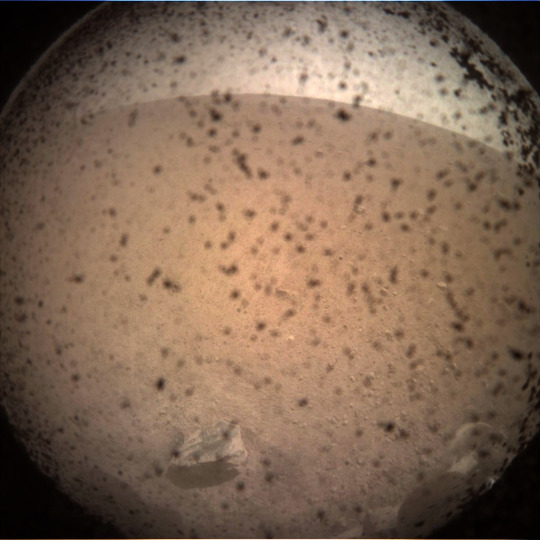
The front view from InSight’s Instrument Context Camera while covered with a protective cap to prevent ingress of dust during landing. Credit: NASA/JPL-Caltech.

The first image from InSight. Credit: NASA/JPL-Caltech.

The Jezero Crater Delta on Mars. Credit: NASA/JPL-Caltech/MSSS/JHU-APL.
17 notes
·
View notes
Link
An international team of scientists has found the cause of the largest Martian seismic event, or Marsquake, observed by NASA’s Interior Exploration using Seismic Investigations, Geodesy and Heat Transport (InSight) Mars lander. After ruling out a meteor impact, they concluded the event must have been caused by a release of stress within the planet’s crust. The forceful quake occurred on May 4, 2022, at 23:23 UTC, on the 1222nd Martian day, or sol, of InSight’s mission. The quake, also known as S1222a, was five times stronger than any event InSight had observed before. It shook the planet at a magnitude of 4.7 and the vibrations reverberated through Mars’ crust for approximately six hours. The event showed similarities with earlier Martian seismic events, which have since been identified as meteor impacts, so scientists scoured the Martian surface for a possible impact crater. To do this, the team used observations from missions currently in orbit around Mars, engaging in an international collaboration between the European Space Agency (ESA), the Chinese National Space Agency, the Indian Space Research Organisation, and the United Arab Emirates Space Agency (UAESA). “This project represents a huge international effort to help solve the mystery of S1222a, and I am incredibly grateful to all the missions who contributed,” said study lead Benjamin Fernando of the University of Oxford. “I hope this project serves as a template for productive international collaborations in deep space.” The area that was imaged in the search for a possible impact crater. The yellow star shows S1222a’s expected epicenter and the yellow rectangle is the primary search area. A, B, and C show the observations and D shows the probability map for the event’s epicenter. (Credit: Fernando et al.) For the largest meteor impacts detected by InSight, scientists found craters with a diameter of up to 150 meters. If S1222a was also caused by a meteor impact, the team expected to find a crater with a diameter of 300 meters and a blast zone that would be 180 kilometers across. Each contributing team looked for this potential crater using their spacecraft, comparing observations from before and after the Marsquake. See AlsoInSight UpdatesSpace Science CoverageL2 Future SpacecraftClick here to Join L2 “We are willing to collaborate with scientists around the world to share and apply this scientific data to get more knowledge about Mars, and are proud to have provided data from the color imagers on Tianwen-1 to contribute to this effort,” said Jianjun Liu of Chinese Academy of Sciences. But why did the team need observations from this many satellites? “Making the association between a given seismic event and a fresh crater is challenging,” the scientists wrote. They can identify fresh craters by the presence of a blast zone, which fades over time but is easy to spot on lower-resolution images taken shortly after the impact. Depending on the impact terrain, however, blast zones can be obscured or less prevalent, so the team still needed high-resolution images to exclude the possibility of an impact. Another challenge is the low availability of high-resolution images from spacecraft in orbit. The high-resolution cameras on the satellites have narrow fields of view and can only observe small areas at one time. Because of this, the region may not have been imaged before the impact, making it impossible for the teams to compare before and after photos in the search for a fresh crater. NEW: A global team of scientists have confirmed the results of a search for the source of the largest-ever seismic event recorded on Mars. The study suggests the quake was the result of enormous tectonic forces within Mars’ crust.https://t.co/wuXo9T0W9v — University of Oxford (@UniofOxford) October 18, 2023 To overcome these hurdles, the scientists had to look at the combined output of all current missions in orbit around Mars. “This experiment shows how important it is to maintain a diverse set of instruments at Mars, and we are very glad to have played our part in completing the multi-instrumental and international approach of this study,” said Daniela Tirsch, Science Coordinator for the High-Resolution Stereo Camera onboard ESA’s Mars Express Spacecraft. With all observations combined, the team found no evidence of an impact crater that could explain the measured seismic event and concluded that the Marsquake must thus have been a tectonic event in the planet’s own crust. “We still think that Mars doesn’t have any active plate tectonics today, so this event was likely caused by the release of stress within Mars’ crust,” said Fernando “These stresses are the result of billions of years of evolution; including the cooling and shrinking of different parts of the planet at different rates.” This Marsquake’s epicenter was located 2,200 kilometers from InSight, but well outside the Cerberus Fossae region which is known for its tectonic activity. Map showing InSight’s location (red triangle), the location of S1222a’s expected epicenter (blue dot) and probability ellipse (blue), Cerberus Fossae (black lines) and the locations of other seismic events (purple dots). (Credit: Kawamura et al. (2023)) “We still do not fully understand why some parts of the planet seem to have higher stresses than others, but results like these help us to investigate further,” said Fernando. “One day, this information may help us to understand where it would be safe for humans to live on Mars and where you might want to avoid!” The S1222a quake occurred near the end of InSight’s mission. By that time, some of the lander’s sensors were turned off to conserve power as dust had begun accumulating on its solar panels, reducing the lander’s available power to less than 20% of the original capacity. Because of this, Fernando’s team was limited to using seismic data, as no measurements of atmospheric pressure and wind were recorded. InSight was launched on May 5, 2018, by the United Launch Alliance atop its Atlas V 401 rocket from Vandenberg Air Force Base in California. The mission landed in Mars’s Elysium Planitia region on Nov. 26, 2018. When NASA retired the lander in December 2022, it had detected 1,319 Marsquakes. Currently, scientists are continuing to analyze InSight’s data even after the mission ended. “This has been a great opportunity for me to collaborate with the InSight team, as well as with individuals from other major missions dedicated to the study of Mars,” said Dimitra Atri of New York University Abu Dhabi, who contributed data from UAESA’s Hope Spacecraft. “This really is the golden age of Mars exploration!” Fernando et al.’s study was published in Geophysical Research Letters on Oct. 17, 2023. (Lead image: Illustration showing InSight on the Martian surface. Credit: NASA/JPL-Caltech) The post Through international collaboration, scientists find cause of InSight’s most powerful Marsquake appeared first on NASASpaceFlight.com.
0 notes